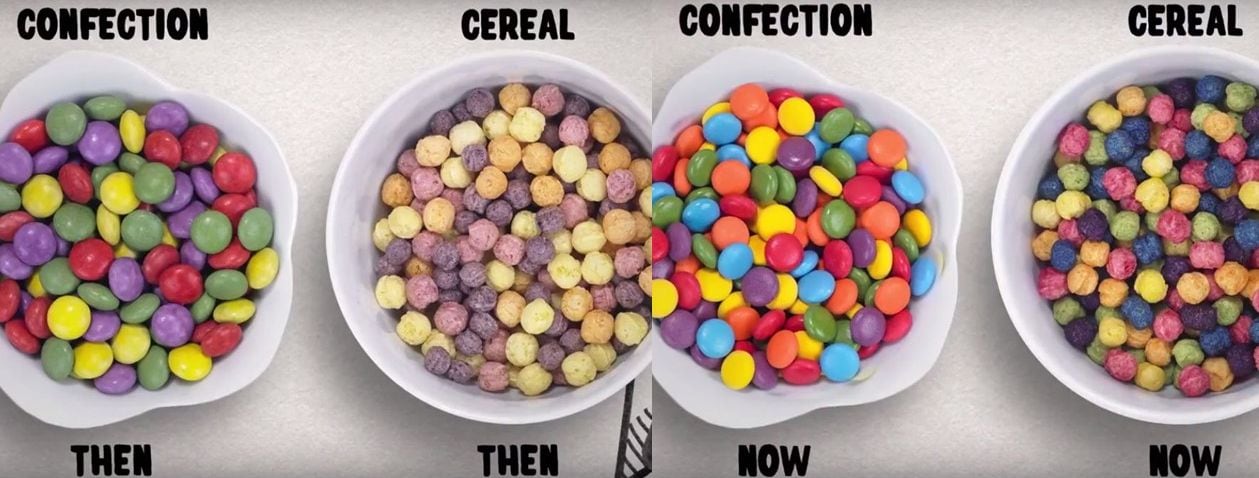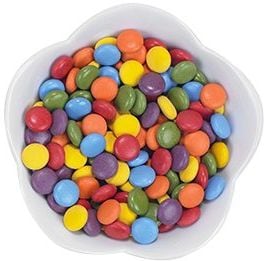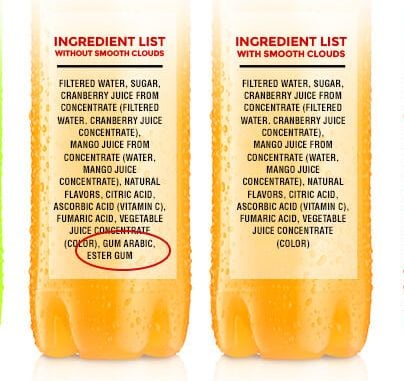MYTH 1: You have to sacrifice shade vibrancy with natural colors
Vivid natural shades are now available for most applications, claims director of global food marketing David Rigg, who says Sensient’s vegetable-juice-derived SupraRed color can now match the performance of Red 40 or carmine [a bug-derived red many formulators now spurn] in bakery and extruded cereals, for example, thanks to a proprietary purification process that removes components that make the reds turn purple at a neutral or high pH, or go brown when heated.
“In the past you had to have extremely high usage rates or be willing to accept a more muted color. Not anymore... We’re also getting better at learning when in a process to apply natural colors so they don’t lose their vibrancy.”
MYTH 2: Shade variability should be expected with natural colors
Consistent, standardized shades mean there is no reason for food manufacturers to put up with variability when using natural colors anymore, notes technical services manager Megan Longhi, while the great thing about having a bigger pack of crayons is that you can create more interesting shades.
“We can now create really vibrant superfruit-type purple colors that weren’t available in the past using synthetics, where you could only really combine Red # 40 with Blue #1, which gives you an ugly blue gray concord grape shade. Now we can combine our vegetable juice based blue color with other anthocyanin or vegetable juice based natural colors and we can achieve vibrant indigos across all the different pH ranges.”
The number of natural colors in the toolbox is also slowly but steadily growing, says Rigg, "So for example there’s a petition in the works – a collaborative effort involving several companies – to get [safflower derived] Carthamus yellow approved in the US, which is approved in the EU and some other regions, and is a great yellow #5 replacer, especially in beverages.
“In the past with synthetics we were operating with a 16 crayon box, now with natural it’s like you’ve got 64 crayons in the box."
MYTH 3: Off-flavors are a common problem with natural colors
“This is an area where significant progress has been made in recent years," says technical director David Gebhardt. "It is accurate that many natural color sources have the potential to impart off-notes in certain applications. However, new filtration and purification technologies can remove unwanted flavors from botanical color sources.
“When natural colors were less concentrated than they are today, usage rates were also higher and that would impact flavor and texture in some applications if you wanted a really vibrant shade,” adds Rigg.
“But we’re producing far more concentrated natural colors now, so you don’t have to use as much to achieve the same vibrancy, and you don't get the same off flavors.”
MYTH 4: Natural colors are less stable
“We find this perception is pretty common, but it isn’t quite accurate,” says Gebhardt.
“For example, in one of our long-term stability studies on panned chocolates, natural colors actually held up better than their synthetic counterparts. And in a light stability challenge for a juice beverage, Red 40 fared significantly worse than the natural red solution that used an anthocyanin vegetable juice. Of course, there are examples where natural colors demonstrate poor stability. Turmeric, for example, does not hold up well to light.”
In some areas, significant progress has been made, says Rigg: “Extrusion used to be a killer – you’ve got heat, pressure, people injecting steam into the process – so cereals, confections, and petfood in the past were a big challenge, but we’ve been able to come up with solutions that can maintain color
vibrancy through the extrusion process and that’s one area where we are seeing some really strong growth.”

MYTH 5: Natural colors are expensive
“It’s true that natural colors are more expensive than synthetics, but given that color is at least as important as flavor when it comes to determining consumer preference, natural colors are not necessarily costly,” says Gebhardt.
“Prices are also stabilizing or coming down, for example, the black carrot used five years ago had a much lower color concentration, but through improvements in breeding and processing technologies that have improved our ability to extract the color, we can now offer something much more concentrated.”
“A little synthetic dye goes a very long way,” adds Rigg.
“They are up to 95% pure color, whereas the pigment levels are typically much lower in say a black carrot, where the pigment level might be 50%, so yes, they cost more, but when you look at cost in use, compared to flavors and sweetener, colors represent a lower cost component. When some people say natural colors are expensive, that’s because they are comparing them with something (synthetics) that is literally a rounding error in a formulation.”

Natural white colors: “Pretty much every single customer is interested in looking at alternatives to [the white colorant] titanium dioxide, and we’ve got options that work across applications with different levels of water activity,” says Sensient director of global food marketing David Rigg.
“We’ve got starch based products which include a blue-ing agent, which means they can be listed on the label as vegetable juice or spirulina, even though what’s actually providing the white color is the starch.”

Do more vibrant colors look less ‘natural’? Recent consumer survey data indicates that taste expectations, purchase intent, and liking scores typically increase with color vibrancy, says director of global food marketing David Rigg. However, sample foods featuring slightly less vibrant shades are perceived as ‘more natural’ than those with brighter shades, even when both options are clearly labeled as being made with natural colors.

Caramel color replacement: A growing number of food manufacturers are looking to replace caramel colors as part of their clean label programs amid concerns over GMOs, 4-MEI and processing aids used in the production of these colors, even though caramel color suppliers have developed options to tackle all of these concerns, says Sensient director of global food marketing David Rigg.
“We’ve got a variety of alternatives including a siena brown fruit juice based color which we can blend with yellows, blues and reds, and we’ve also identified other [new brown color] sources that can help us develop really strong browns that are very stable in multiple applications. This is a focal area for us and in the next year to two years, you will see some exciting stuff coming out of Sensient on this front.”
Do natural colors always meet clean label demands? “Some customers don’t drill down to this level, but we’re definitely getting more questions about incidental additives, propylene gycol, extraction methods, Non GMO Project verified colors, feedstocks, preservatives and additives in natural colors,” says Sensient director of global food marketing David Rigg.
“When it comes to GMOs, the issue is not really about the source material, but more about things like carriers or flow agents, for example corn maltodextrin, but we can always provide customized [Non GMO] solutions that meet our customers' needs. Some customers also believe that consumers don’t want preservatives in their colors - even in trace amounts which don’t have to be declared - so we can do things like package some colors aseptically in order to give customers what they want.”

By incorporating clouding agents such as gum arabic, ester gum, or ester of wood rosin – which make low juice drinks seem more juicy - into color emulsions in its smooth beverage clouds, Sensient can also help beverage companies shorten their ingredients lists, says technical director David Gebhardt: “If the clouding agents are incorporated into the color system as incidental additives, you don’t have to list them separately."
Sensient is also getting a growing number of requests for organic colors, he adds.
“Our natural blue should be certified organic next year, so that will be a really important building block for us as we’re trying to increase [the number of] basic building blocks we have that are certified organic so we can create organic custom blends that span the spectrum.”
